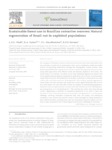Por favor, use este identificador para citar o enlazar este ítem:
http://www.alice.cnptia.embrapa.br/alice/handle/doc/506234Registro completo de metadatos
| Campo DC | Valor | Lengua/Idioma |
|---|---|---|
| dc.contributor.author | WADT, L. H. de O. | pt_BR |
| dc.contributor.author | KAINER, K. A. | pt_BR |
| dc.contributor.author | STAUDHAMMER, C. L. | pt_BR |
| dc.contributor.author | SERRANO, R. O. P. | pt_BR |
| dc.date.accessioned | 2011-04-10T11:11:11Z | pt_BR |
| dc.date.available | 2011-04-10T11:11:11Z | pt_BR |
| dc.date.created | 2008-05-29 | pt_BR |
| dc.date.issued | 2008 | pt_BR |
| dc.identifier.citation | Biological Conservation, v. 141, n. 1, p. 332-346, Jan. 2008. | pt_BR |
| dc.identifier.issn | 0006-3207 | pt_BR |
| dc.identifier.uri | http://www.alice.cnptia.embrapa.br/alice/handle/doc/506234 | pt_BR |
| dc.description | The emergence of Brazilian extractive reserves reinforced the notion that sustainable forest use could play a central role in conservation. Brazil nut is considered a model non-timber product for promoting conservation through use. Demographic studies, however, have demonstrated differential impacts of nut harvest on Brazil nut population structure. Comparing three populations with different forest use histories, degrees of road access, and recent levels of nut harvest, we asked: (1) Are they exhibiting regeneration failure? and (2) Are seedling/sapling densities explained by adult Brazil nut structure, fruit fate and/or overall forest structure? | pt_BR |
| dc.language.iso | eng | eng |
| dc.rights | openAccess | eng |
| dc.subject | Castanha do brasil | pt_BR |
| dc.subject | Produto florestal não madeireiro (PFNM) | pt_BR |
| dc.subject | Manejo florestal | pt_BR |
| dc.subject | Reserva extrativista | pt_BR |
| dc.subject | Extractive reserve | pt_BR |
| dc.subject | Reserva extractiva | pt_BR |
| dc.subject | Nuez del Brasil | pt_BR |
| dc.subject | Productos forestales no madereros | pt_BR |
| dc.subject | Regeneración natural | pt_BR |
| dc.subject | Silvicultura sustentable | pt_BR |
| dc.title | Sustainable forest use in Brazilian extractive reserves: natural regeneration of Brazil nut in exploited populations. | pt_BR |
| dc.type | Artigo de periódico | pt_BR |
| dc.date.updated | 2019-01-08T11:11:11Z | pt_BR |
| dc.subject.thesagro | Castanha do pará | pt_BR |
| dc.subject.thesagro | Bertholletia excelsa | pt_BR |
| dc.subject.thesagro | Regeneração natural | pt_BR |
| dc.subject.nalthesaurus | Brazil nuts | pt_BR |
| dc.subject.nalthesaurus | Nontimber forest products | pt_BR |
| dc.subject.nalthesaurus | Sustainable forestry | pt_BR |
| dc.subject.nalthesaurus | Natural regeneration | pt_BR |
| riaa.ainfo.id | 506234 | pt_BR |
| riaa.ainfo.lastupdate | 2019-01-08 -02:00:00 | pt_BR |
| dc.identifier.doi | 10.1016/j.biocon.2007.10.007 | pt_BR |
| dc.contributor.institution | LUCIA HELENA DE OLIVEIRA WADT, CPAF-AC | pt_BR |
| dc.contributor.institution | KAREN A. KAINER, UNIVERSITY OF FLORIDA | eng |
| dc.contributor.institution | C. L. STAUDHAMMER, UNIVERSITY OF FLORIDA | eng |
| dc.contributor.institution | RODRIGO OTÁVIO PEREA SERRANO, UNIVERSIDADE FEDERAL DO ACRE. | eng |
| Aparece en las colecciones: | Artigo em periódico indexado (CPAF-AC)  | |
Ficheros en este ítem:
| Fichero | Descripción | Tamaño | Formato | |
|---|---|---|---|---|
| 17643.pdf | 461,71 kB | Adobe PDF |  Visualizar/Abrir |









